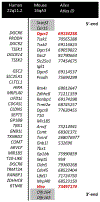Differential resting-state patterns across networks are spatially associated with Comt and Trmt2a gene expression patterns in a mouse model of 22q11.2 deletion
- PMID: 34455061
- PMCID: PMC9063447
- DOI: 10.1016/j.neuroimage.2021.118520
Differential resting-state patterns across networks are spatially associated with Comt and Trmt2a gene expression patterns in a mouse model of 22q11.2 deletion
Abstract
Copy number variations (CNV) involving multiple genes are ideal models to study polygenic neuropsychiatric disorders. Since 22q11.2 deletion is regarded as the most important single genetic risk factor for developing schizophrenia, characterizing the effects of this CNV on neural networks offers a unique avenue towards delineating polygenic interactions conferring risk for the disorder. We used a Df(h22q11)/+ mouse model of human 22q11.2 deletion to dissect gene expression patterns that would spatially overlap with differential resting-state functional connectivity (FC) patterns in this model (N = 12 Df(h22q11)/+ mice, N = 10 littermate controls). To confirm the translational relevance of our findings, we analyzed tissue samples from schizophrenia patients and healthy controls using machine learning to explore whether identified genes were co-expressed in humans. Additionally, we employed the STRING protein-protein interaction database to identify potential interactions between genes spatially associated with hypo- or hyper-FC. We found significant associations between differential resting-state connectivity and spatial gene expression patterns for both hypo- and hyper-FC. Two genes, Comt and Trmt2a, were consistently over-expressed across all networks. An analysis of human datasets pointed to a disrupted co-expression of these two genes in the brain in schizophrenia patients, but not in healthy controls. Our findings suggest that COMT and TRMT2A form a core genetic component implicated in differential resting-state connectivity patterns in the 22q11.2 deletion. A disruption of their co-expression in schizophrenia patients points out a prospective cause for the aberrance of brain networks communication in 22q11.2 deletion syndrome on a molecular level.
Keywords: 22q11.2 deletion; Comt; Functional connectivity; Mouse; Schizophrenia; Trmt2a; ventral tegmental area.
Copyright © 2021. Published by Elsevier Inc.
Figures






References
-
- Bertolino A, Rubino V, Sambataro F, Blasi G, Latorre V, Fazio L, et al., 2006. Prefrontal-hippocampal coupling during memory processing is modulated by COMT val158met genotype. Biol Psychiatry. 60(11), 1250–1258. - PubMed
-
- Brandl F, Avram M, Weise B, Shang J, Simoes B, Bertram T, et al., 2019. Specific Substantial Dysconnectivity in Schizophrenia: A Transdiagnostic Multimodal Meta-analysis of Resting-State Functional and Structural Magnetic Resonance Imaging Studies. Biol Psychiatry. 85, 573–583. - PubMed
Publication types
MeSH terms
Substances
Grants and funding
LinkOut - more resources
Full Text Sources
Molecular Biology Databases
Miscellaneous

